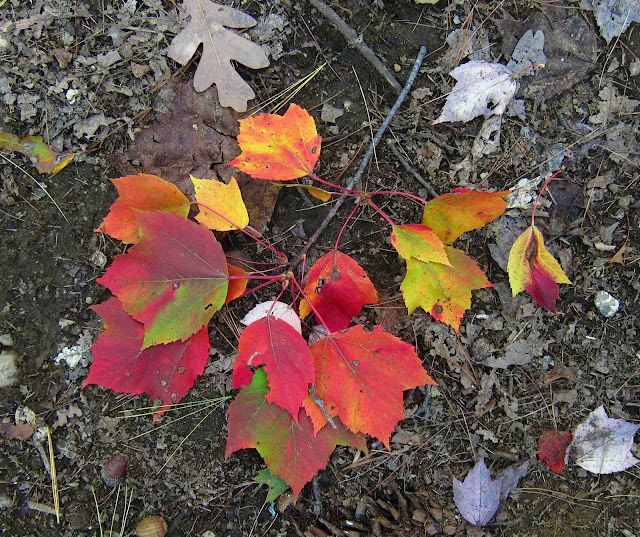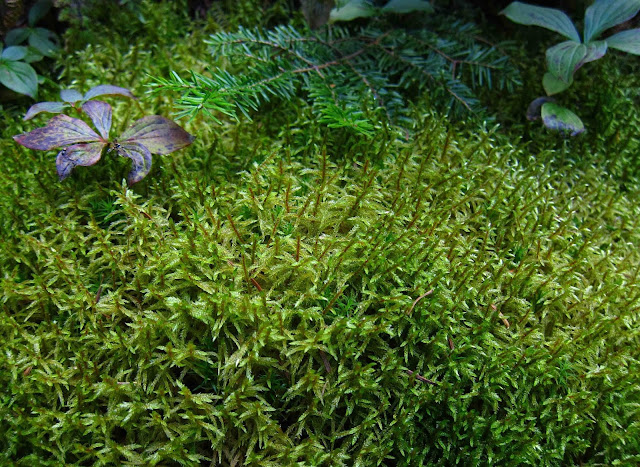Saturday, October 10: Moreau Mudflats and Waterfall Rocks
When Nancy asked me if I knew of any good liverwort locations at Moreau Lake State Park, I immediately thought of the mudflats surrounding Mud Pond, home to one of the most abundant populations of the liverwort Ricciocarpus natans I have ever seen. Of course, I am not a member of the liverwort cognoscenti, as my friends are, but even they were impressed to see such a vast carpet of this normally floating liverwort, now stranded on the mud by low-water conditions this summer. We were joined to explore this and other areas of the park by our friend Sue Pierce, seen photographing a liverwort at the center of the photo above, while Nancy (red jacket) looks for additional bryophytes and Jerry takes a magnified look at one of the liverworts he'd already found.
The flat, lime-green plants covering the dark mud are the Ricciocarpus liverworts, sharing this habitat with many other shoreline plants including Water Purslane (red stems) and various grasses and reeds.
Here's a closer look at this pretty liverwort, which in the normal course of its life would be floating freely on the surface of the pond.
After thoroughly exploring the sun-exposed mud, we next moved into the surrounding woods, following a dry creekbed under Bitternut Hickory trees. Although there was no running water flowing along the creekbed, the forest floor was damp and mossy and home to a number of interesting fungi, including these itty-bitty orange lollypop-shaped mushrooms sprouting from a rotting log, the smallest of which were no bigger than the head of a dressmaker's pin.
A second tiny fungus we found was this group of wee little cup-shaped fungi called Bird's Nest Fungus, a common-name suggested by the presence of tiny "eggs" within each cup. These "eggs" are actually the spore-containing fruits, which will be splashed out of the cups when it rains and will attach themselves by filaments to surrounding upright trees, the better to spread their spores on the passing breeze. (To see some photos of this process, see my post from March 21, 2012.)
From wee little fungi no bigger than pinheads, we next found this fungus as big as a beachball! It's called Giant Puffball, and it sure lives up to its name. It's also good to eat, sliced into steaks and fried in butter, but we left it where it was for others to marvel at.
When Nancy and Jerry informed Sue and me that other likely locations for liverworts are the rocky banks around waterfalls, we knew where we should go next in the park. There's a pretty creek that tumbles in waterfalls down the mountains, and we could access this site from the Red Oak Ridge Trail, which is where we went next. Due to this summer's lack of rainfall, our creek and its waterfalls were barely evident, with only a trickle of water slowly moving among the rocks, but the thing about liverworts is that they are very persistent and can be found throughout the year and in varying climatic conditions. So our search was not in vain.
I know that Nancy and Jerry found a number of common liverworts here in this habitat, but I got a photo of only one of them. This is a pretty, leafy liverwort called Plagiochila asplenioides, and I surely would have mistaken it for a moss if my friends had not identified it for me.
We did indeed find many mosses along the waterfalls' course, and this is one of the prettiest. It looks like tiny palm trees, and its name, Atrichum undulatum, refers to the ripples (undulations) of its leaves.
While most other wildflowers are fading fast, the flowers of the forest understory tree Witch Hazel have just begun to unfurl their narrow ribbony petals. We found many clusters of blooms we could bury our noses in, to breathe in its scent, as faintly and delightfully fragrant as clean laundry dried outdoors in the sun.
Although the surrounding forest was still mostly green, we had a foretaste of the spectacle yet to come in this single switch of a Red Maple twig we found on the path, the leaves containing all the glorious foliage colors of autumn.
A fine day spent with good friends in a beautiful woods learning lots of new things. And this was just the beginning of a wonderful weekend!
* * *
Sunday, October 11: Alpine Explorations at Whiteface Mountain
Our gorgeous weather continued on Sunday, a perfect day for ascending to the summit of Whiteface Mountain, one of the highest peaks in the Adirondacks. Lucky for me with my mending knee, we didn't have to hike to the top, thanks to the toll highway that delivered us most of the way to the summit. Since this highway closes for the year after Columbus Day, we -- and it seemed like the rest of the world as well -- were happy to gain such easy access to some of the most gorgeous views in the northeastern United States. Aside from enjoying the views, we were here to discover what liverworts thrived in these alpine conditions, a special area of interest for Nancy Slack, who is the co-author of the book, Field Guide to the New England Alpine Summits.
On this beautiful day, Nancy and Jerry and I were joined by another friend named Anne, who also shares a passion for liverworts and other bryophytes. I was especially happy to have Anne's company exploring the mountain-top forest, since I was unable to accompany Nancy and Jerry when they opted to take a rugged trail up to the summit from a parking area only midway from the top. I tested my mending-but-still-weakened knee on the first 20 yards of this trail, but decided that I was not yet up to the task of scrambling up the hip-high slippery boulders that Nancy and Jerry scampered up with relative ease. Since Anne was reluctant to brave that trail as well, the two of us pushed through some roadside shrubbery to see what we could find within a few yards from the road.
Lots and lots of moss in here, that's for sure!
Probably the single-most abundant moss in the Adirondacks is this thick, soft, reddish-stemmed moss called Pleurozium shreberi, which simply invites you to sink your hands into its bushy softness.
Some other plants thriving among the mosses were Bunchberry and Stiff Clubmoss.
Some of the Bunchberries still had beautiful red fruits.
Here were Goldthread's shiny leaves separating clumps of Broom (left) and Haircap mosses.
Anne and I eventually climbed the road to a parking area just below the summit of Whiteface, although Anne's fear of exposed heights prevented her from scaling the last 500 yards to the absolute top of the mountain. Luckily, there's a cozy cafe right there to take refuge in, while I decided to test my strength by climbing up this walkway to the top. And yes, hooray! I made it!
One reward was this truly spectacular view of Lake Placid far below.
While Nancy and Jerry were scouting the rocks for alpine liverworts along the foot trail up the other, leeward, side of the summit, I clung to iron handrails to prevent being blown off the mountain by 40+ mile-per-hour winds. While I didn't see any liverworts here, I did see thousands of these disks of lime-green lichens everywhere on the granitic rocks that lined the walkway. (Can anybody tell me their name?) UPDATE: Nancy got back to me to inform me that this is Rhizocarpon geographicum, also known as Map Lichen.
Here and there, the ubiquitous green disks were punctuated by bright-orange disks of the aptly named Orange Sunburst Lichen (Xanthoria elegans).
When I reached the summit and rounded the topmost structures up there, I began to descend the same trail that Nancy and Jerry were ascending. I didn't go far, but found a quiet perch here on the leeward side of the mountain to sit and wait for my friends to emerge from the krummholz thickets. (Which they did, eventually, muddy-kneed and still standing, chattering of all the alpine liverworts they had seen.) Here in this sheltered stretch of the trail, I found evidence of some of the alpine flowers I remembered from earlier trips up here in past summers. Even though its flowers had long faded, I recognized this Three-toothed Cinquefoil (Sibbaldiopsis tridentata) by the three teeth at the end of its multi-colored leaves. So pretty in it autumn foliage!
As the afternoon shadows lengthened, it was time to leave the mountain and make our way home, delighting in such splendid views as this as we descended.
* * *
Monday, October 12: More Mudflats (and More) at Moreau Lake
The holiday weekend continued into a glorious Monday, so warm and bright and beautiful I even convinced my husband Denis to join me for a walk around Moreau Lake. Because of my habit of dropping to my knees every few feet to photograph flowers, or stall by a stand of reeds while I wait for that dragonfly to return to its perch, my husband usually prefers not to join me. But today was just too gorgeous to stay indoors, and I promised I'd had my fill of botanizing with my botanical pals the previous two days. So off we went together. Moreau Lake is certainly one of the sweetest places to walk on such a beautiful day, especially now that low-water levels have exposed broad sandy beaches for strolling on.
Well, in one of the coves of the lake, that broad beach was not sand, but exposed mud instead. And you probably can guess what that means: time to look for exposed mudflat plants! There goes my husband, far ahead of me, as I study the mud to see what I can find.
And what did I find but more LIVERWORTS! Yes, they were the same species -- Ricciocarpus natans -- my friends and I had studied on Saturday over at Mud Pond, but never had I seen them here on Moreau Lake. So of course I had to take a few moments to photograph them.
Even my husband stopped for a moment to admire the vibrant leaves of this Sassafras tree glowing at the edge of the woods.
And both of us sat together a good long while, resting on a bench along the north shore, mesmerized by the dancing sparkles out on the blue, blue water, enchanted by the luminous stained-glass colors of sunlight streaming through the trees.































4 comments:
Boy, you are making up for lost time, out there three days in a row! Sound wonderful!
What a wonderful time you must have had. I enjoyed my trip with you through your pictures. Thank you very much for sharing.
The ADK High Peaks surely are beautiful this time of year. As are the smaller plants of the less common habitats above timberline and in perennially damp [places.
Great fungi and lichen finds! Everything looks so damp there, we've been so dry here in Wisconsin the last two months that fungi are not as prevalent as usual.
Post a Comment